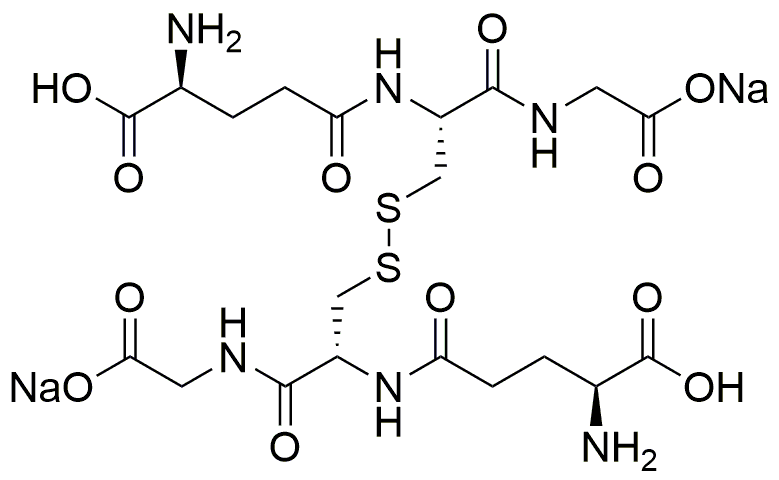L-Glutathione oxidized disodium salt is widely utilized in research focused on:
- Antioxidant Applications: This compound serves as a powerful antioxidant in various formulations, helping to protect cells from oxidative stress. It's commonly used in cosmetics and skincare products to promote skin health and reduce signs of aging.
- Pharmaceuticals: In the pharmaceutical industry, it is used in drug formulations to enhance bioavailability and stability. Its properties help improve the effectiveness of certain medications, particularly those targeting oxidative damage.
- Food Preservation: The compound is also applied in the food industry as a preservative. It helps maintain the quality and shelf-life of food products by preventing oxidation, thereby preserving flavor and nutritional value.
- Research in Cellular Biology: Researchers utilize it in laboratory studies to investigate cellular processes, particularly those involving oxidative stress and detoxification pathways. Its role in cell signaling makes it a valuable tool in biochemistry research.
- Detoxification Support: In health supplements, it is promoted for its potential to support the body’s natural detoxification processes. This application is particularly relevant for individuals looking to enhance their overall health and wellness.
General Information
Properties
Safety and Regulations
Applications
L-Glutathione oxidized disodium salt is widely utilized in research focused on:
- Antioxidant Applications: This compound serves as a powerful antioxidant in various formulations, helping to protect cells from oxidative stress. It's commonly used in cosmetics and skincare products to promote skin health and reduce signs of aging.
- Pharmaceuticals: In the pharmaceutical industry, it is used in drug formulations to enhance bioavailability and stability. Its properties help improve the effectiveness of certain medications, particularly those targeting oxidative damage.
- Food Preservation: The compound is also applied in the food industry as a preservative. It helps maintain the quality and shelf-life of food products by preventing oxidation, thereby preserving flavor and nutritional value.
- Research in Cellular Biology: Researchers utilize it in laboratory studies to investigate cellular processes, particularly those involving oxidative stress and detoxification pathways. Its role in cell signaling makes it a valuable tool in biochemistry research.
- Detoxification Support: In health supplements, it is promoted for its potential to support the body’s natural detoxification processes. This application is particularly relevant for individuals looking to enhance their overall health and wellness.
Documents
Safety Data Sheets (SDS)
The SDS provides comprehensive safety information on handling, storage, and disposal of the product.
Product Specification (PS)
The PS provides a comprehensive breakdown of the product’s properties, including chemical composition, physical state, purity, and storage requirements. It also details acceptable quality ranges and the product's intended applications.
Certificates of Analysis (COA)
Search for Certificates of Analysis (COA) by entering the products Lot Number. Lot and Batch Numbers can be found on a product’s label following the words ‘Lot’ or ‘Batch’.
Numéro de catalogue
Numéro de lot/série
Certificates Of Origin (COO)
This COO confirms the country where the product was manufactured, and also details the materials and components used in it and whether it is derived from natural, synthetic, or other specific sources. This certificate may be required for customs, trade, and regulatory compliance.
Numéro de catalogue
Numéro de lot/série
Safety Data Sheets (SDS)
The SDS provides comprehensive safety information on handling, storage, and disposal of the product.
DownloadProduct Specification (PS)
The PS provides a comprehensive breakdown of the product’s properties, including chemical composition, physical state, purity, and storage requirements. It also details acceptable quality ranges and the product's intended applications.
DownloadCertificates of Analysis (COA)
Search for Certificates of Analysis (COA) by entering the products Lot Number. Lot and Batch Numbers can be found on a product’s label following the words ‘Lot’ or ‘Batch’.
Numéro de catalogue
Numéro de lot/série
Certificates Of Origin (COO)
This COO confirms the country where the product was manufactured, and also details the materials and components used in it and whether it is derived from natural, synthetic, or other specific sources. This certificate may be required for customs, trade, and regulatory compliance.


